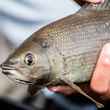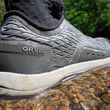We’ve all done it. You grab that brand new rod off the rack, hold it at arm’s length and wiggle it. But what did that just tell you? Unless you’ve cast hundreds of rods, probably little about how that rod fishes and whether or not you should add it to your ever-expanding quiver.
What about the awards a fly rod has won? What does that tell you about how right a rod is for you? Again, probably little.
Tarot cards, Dr. Phil, Meredith Baxter-Birney. Add these to the list of things that will do little to help you narrow down your fly rod choices.
Thankfully, evaluating a fly rod for purchase is a relative straightforward process. Here are some guidelines on selecting a new rod, how to gather information on it and what you should really be looking for in a new stick before you drop 800 simoleons on it.
The Aesthetic
The first thing you notice. From the rod’s finish, wraps and cork work, if a rod doesn’t appeal to you in some capacity you’ll likely be biased towards it from the start. Bad looking rods don’t sell. Manufacturers go through great lengths to make rods appeal visually to consumers. The hope is that you’ll feel an immediate connection the first time you look at a rod, especially if it’s a high-end model.
But, while most of us still judge a book by its cover when it comes to fly rods, we all know we shouldn’t. So I often recommend testing even rods that don’t visually appeal, as you always have the option of finding a custom rod builder to build you a finished rod from the blank should it cast to your liking. Some manufacturers even offer a custom shop where you can order a factory rod customized to your tastes.
In the Shop
Here it is. You knew it was coming. What exactly do you learn about from that first grab and “wiggle” of the rod? One answer is stiffness, how much and where the rod bends. Wiggling the rod can also give you some idea of a rod’s recovery speed, which is how quickly a rod returns to straight after it has been bent. This is partially a function of stiffness, but not entirely.
But what does this tell you about how the rod will perform in the field, loaded with a wet fly line? Unfortunately, not much. The way a rod casts and performs is imparted by the taper and how it loads the line during the cast, none of which can be determined by just standing in the shop holding a dry rod.
That’s not to say that the wiggle test is useless, it isn’t. But it should be regarded as a general test for evaluating the character of a rod rather than an attempt to understand how it performs on the water.
And, believe it or not, there is a right way and a wrong way to do the wiggle test. This is important because done incorrectly, the wiggle test does become useless. In fact, the wiggle test probably shouldn’t be called the wiggle test at all. Instead of wiggling the rod give it a quick “snap” (a single up and down motion) and pay attention to where the rod bends and how fast the rod comes to a standstill afterwards.
It should go without saying that slower actions rods like bamboo and glass will bend deeper down the rod. Graphite should bend and wiggle more towards the mid section of the rod and tip.
Another thing that many rod shoppers focus intently on, but which you should not to spend too much time worrying about in the shop is the weight of the rod. With modern graphite, differences between rods often amount to fractions of an ounce. In reality, that extra 1/8 of an ounce between one brand and another really makes no difference, especially with trout-sized rods. Honestly, when was the last time you stopped fishing because the rod was too heavy? When considering rods for saltwater and big game where you’ll be casting foot-long leviathan flies all day, weight may play more of a factor but should still be near the bottom of your list of things to worry about when making a purchasing decision. One exception may be in the realm of bamboo and glass rods, which are significantly heavier than carbon.
The Test Cast
This is where you can truly put that rod through its paces. Have the shop line the rod with the correct line weight and get it outside. An important thing to consider when casting rods at a shop is that most fly shops don’t have demo reels strung up with every type of line currently on the market. If you’re looking at fast action sticks, then be sure that the line you’re test casting with is properly matched to the rod. For instance a Sage One or Orvis H2 nine foot five weight will cast like crap with most 5-weight demo lines. Instead, ask to over-line the rod, throw on a 6-weight line and consider purchasing a line that will match the rods performance (e.g.. a RIO Grand or SA GPX). Most modern fast action rods will perform better over-lined as the extra grain weight of the line will help load those stiffer rods.
Now that you’re strung up and ready to go, start casting but resist the urge to throw only hero casts. You want a rod that will perform best for how you actually fish it, not for competition casting. Is your last name Rajeff? If not, then you don’t need to launch 80’ of line. Work with the rod and focus on how accurately you can cast it.
It is also important to note that it is difficult to judge distance when out on the lawn, so walk off 20-30 paces and mark it with the Clif bar in your pocket. 30 feet is a lot closer that you think. The rod’s accuracy and how well it matches your casting and fishing style are far more important than how much line it can chuck.
Are you testing a 4-weight 8’ trout rod for dry flies? That rod should cast and load the line best between 15 and 40’ of line. If you’re test casting larger rods for streamers ask if you can attach a fly with some weight to the leader (cut off the hook in case neighborhood cats are tempted). This will give you a better idea of the rod’s power for turning over larger flies. This is also when you should try and chuck that line 50’-60’. And, again, remember that accuracy is far more important than distance. Even in saltwater situations it’s exceedingly rare that you will need to make an 80 to 100’ cast to catch a fish.
Repeat ad nauseam
Determine what kind of rod your looking for and cast and compare as many as you can of the same type (e.g. 9’ 5 weights in the 4 to $500 range) at the same time. It’s a lot easier to make a decision if you cast rods back-to-back and alternate between two or three rods comparing the pros and cons as you cast.
The Price Tag
Buy the best rod you can afford.
Don’t be intimidated by the price tag. You’re spending the money on a lifetime investment. The warranty on that rod you’re about to buy will cover it for life so take the time and make sure it’s a rod you’ll want to fish for the rest of yours.
That said, equally important as not letting the price tag talk you out of buying a rod is not letting the price tag talk you into buying a rod. Just because a rod costs more doesn’t mean it is a better rod. The motto above remains true — buy the best rod you can afford — not the most expensive rod you can afford.
The Decision
Finalize your decision based on what rod feels best to you based on your casting style and what application you intend for the rod. Some casters perform better with medium action rod and some with fast action rods. Buying a new rod is a very personal experience and a significant investment for most of us. Take your time with the process, learn about the rods and, most importantly, cast them. Rod reviews and advice from professionals can be invaluable, but you must ultimately decide what tool will work best for you. Ignore the hype behind a rod and try it out for yourself.





























Comments
Tony Bishop replied on Permalink
One 'test' that should be done before you buy is to make sure the rod has been built on the 'spline' (or spine). The spline is formed where the glass or carbon fibres meet or overlap when wrapped on the mandril. The spline should be straight from handle to tip, and the guides should align along the spline. It is easy to test this - have someone hold the rod handle at about 3 feet above horizontal and hold steady, then grip the rod tip between thumb and forefinger and lightly pull down a foot or two. If the rod is not built on the spline the tip will try and twist out of your grip. Another method is to rest the tip of the handle on the floor, at about 3 feet from the rod tip, rest the rod in the curved palm of your hand. Then about three feet below, with the flat of your hand roll the rod. The rod will 'kick' very noticeably if the spline is out of line.
A rod not built on the spline will play havoc with casting, and playing a fish.
When I owned an operated Just Fish' in Auckland NZ we tested every rod before they went up on the shelf.
Pages